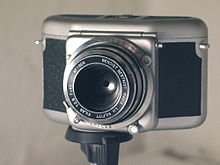- Mecaflex
-
Mecaflex SEROA c.1958 The Mecaflex is a 35mm SLR camera for 50 exposures of 24×24mm. It was presented at the Photokina in Cologne in 1951, and launched at the market some two years later. The design is by Heinz Kilfitt, also known for the design of the original Robot camera and the Kowa Six. [1]
The camera is based on a rather revolutionary concept, utilising the newly developed Prontor/Compur reflex shutters, which would pave the way for reputable camera designs like the 1953 Contaflex, the 1956 Retina Reflex, the 1957 Hasselblad 500, and the 1959 Voigtländer Bessamatic. However, it does not have the built-in eyelevel pentaprism finder, first seen on 35mm SLR cameras in 1949. In stead, it has a waist-level finder with a central split-image rangefinder complemented by spectacular magnifier incorporating a central loupe. Looking into it, using one eye only, the loupe covers exactly the rangefinder central area. [2]
Contents
Description
The complete camera top, hinged at the front, is a flush cover with no protruding controls. When flipped open, it reveals the waist-level finder. On the right-hand side is the wind-on lever with the manual reset frame counter on top and the remote release threaded shutter button. To the left is the rewind knob with a film reminder on top. When the top lid is fully opened, the large square magnifier swings up over the focusing screen. An action finder is also incorporated into the top cover. At the base are the ¼ inch tripod socket, the A/R rewind switch, and a release button for the removable back.
The Mecaflex is equipped with a unique breech-lock lensmount operated by a lever at five-o-clock at the front. Sliding the lever toward six-o-clock releases the lens. The shutter speed dial surrounds the lensmount. The lens diaphragm is semi-automatic preset, operated by a small protrusion at seven-o-clock at the lens mount. When the camera is wound on, the lens aperture ring should be turned anti-clockwise while depressing a small release button on it and returned to the required preset aperture value. In this way, the lens is wide open for bright finder image and ready to shut down automatically upon shutter release. Focusing is accomplished using the left-hand lever on the lens. The PC sync. contact is situated at the top right on the edge of the lens panel. On the Metz manufactured cameras, an M/X synchronisation selector it placed at the upper left corner of lens panel, and the shutter speeds extend to 1/300 sec. [3]
The Mecaflex is built of beautifully cast metal alloy parts with a matte chrome finish and decorated with a striped black body covering material. The camera, at first a Metz product for which Kilfitt was to supply the lenses, was manufactured at the Metz Apparatefabrik in Fürth, Germany; but reputedly, due to conflicting interests, the production was taken over by Kilfitt and moved to Monaco in 1958, and manufactured there for another seven years. Apart from the SEROA markings at the top to this effect, these later cameras have a different fine grain body covering material, the speeds extend to 1/250 sec. and the M/X flash sync switch is left out, the feature conspicuously missing on the top left of the lens panel. [4]
Lenses
Kilfitt was a reputable lens manufacturer, well known for designs like the 1955 Macro Kilar series and the manufacture of the Voigtländer 2.8 / 32-86mm Zoomar. He started lens manufacturing in Munich in 1941 and expanded production to Liechtenstein in 1947, but production was later gathered in Munich. However, only a limited number of lenses were made for the Mecaflex.
- Kilfitt Kilar 2.8 / 40mm licensed by Benoist-Berthiot, Paris
- Kilfitt Kilar 3.5 / 40mm
- Kilfitt Tele-Kilar 4 /105mm
The camera came in a small box complete with a zippered case and a neck strap. Accessories included an extremely rare add-on eyelevel mirror finder that would attach inside the folding finder.
Two versions
Metz Mecaflex:
- Manufactured from 1953 on, for about five years
- Shutter speeds B, 1 to 1/300 sec.
- M/X synchronisation selector switch
- Striped pattern body cover
Kilfitt Mecaflex:
- Manufactured in Monaco from 1958 on by SEROA, for about seven years
- Shutter speeds B, 1 to 1/250 sec.
- No M/X synchronisation selector switch
- Fine-grained pattern body cover
Both camera versions are quite rare, and extremely collectible, the later one is often preferred at the collectors market, especially in top condition and complete in box, with case and chain. The accessory Eyelevel finder and the Tele-Kilar are also highly sought-after items. [1]
References
- ^ a b Michel Auer (1990). The guide to antique cameras, #1712. Editions Camera Obscura, CH-1248 Hermance. ISBN 2903671087.
- ^ Rudolph Lea (1993). The Register of 35mm Single Lens Reflex Cameras Second Ed.. Wittig Books Hückelhoven. ISBN 3889841309.
- ^ John Wade (1990). The Camera, From the 11th Century to the present day. Jessop Specialist Publishing, Leicester. ISBN 0951439235.
- ^ John Wade (1999). The Collector's Guide to CLASSIC CAMERAS 1945-1985. Hove Books, Small Dole UK. ISBN 1897802110.
Categories:- 135 film cameras
- SLR cameras
Wikimedia Foundation. 2010.


